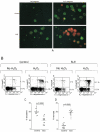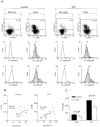Mitochondrial hyperpolarization and ATP depletion in patients with systemic lupus erythematosus
- PMID: 11817589
- PMCID: PMC4020417
- DOI: 10.1002/1529-0131(200201)46:1<175::AID-ART10015>3.0.CO;2-H
Mitochondrial hyperpolarization and ATP depletion in patients with systemic lupus erythematosus
Abstract
Objective: Peripheral blood lymphocytes (PBLs) from systemic lupus erythematosus (SLE) patients exhibit increased spontaneous and diminished activation-induced apoptosis. We tested the hypothesis that key biochemical checkpoints, the mitochondrial transmembrane potential (deltapsim) and production of reactive oxygen intermediates (ROIs), mediate the imbalance of apoptosis in SLE.
Methods: We assessed the deltapsim with potentiometric dyes, measured ROI production with oxidation-sensitive fluorochromes, and monitored cell death by annexin V and propidium iodide staining of lymphocytes, using flow cytometry. Intracellular glutathione levels were measured by high-performance liquid chromatography, while ATP and ADP levels were assessed by the luciferin-luciferase assay.
Results: Both deltapsim and ROI production were elevated in the 25 SLE patients compared with the 25 healthy subjects and the 10 rheumatoid arthritis patients. Intracellular glutathione contents were diminished, suggesting increased utilization of reducing equivalents in SLE. H2O2, a precursor of ROIs, increased deltapsim and caused apoptosis in normal PBLs. In contrast, H2O2-induced apoptosis and deltapsim elevation were diminished, particularly in T cells, and the rate of necrotic cell death was increased in patients with SLE. The intracellular ATP content and the ATP:ADP ratio were reduced and correlated with the deltapsim elevation in lupus. CD3:CD28 costimulation led to transient elevation of the deltapsim, followed by ATP depletion, and sensitization of normal PBLs to H2O2-induced necrosis. Depletion of ATP by oligomycin, an inhibitor of F0F1-ATPase, had similar effects.
Conclusion: T cell activation and apoptosis are mediated by deltapsim elevation and increased ROI production. Mitochondrial hyperpolarization and the resultant ATP depletion sensitize T cells for necrosis, which may significantly contribute to inflammation in patients with SLE.
Figures








Similar articles
-
Persistent mitochondrial hyperpolarization, increased reactive oxygen intermediate production, and cytoplasmic alkalinization characterize altered IL-10 signaling in patients with systemic lupus erythematosus.J Immunol. 2002 Jul 15;169(2):1092-101. doi: 10.4049/jimmunol.169.2.1092. J Immunol. 2002. PMID: 12097418 Free PMC article.
-
Apoptosis and mitochondrial dysfunction in lymphocytes of patients with systemic lupus erythematosus.Methods Mol Med. 2004;102:87-114. doi: 10.1385/1-59259-805-6:087. Methods Mol Med. 2004. PMID: 15286382
-
Mitochondrial dysfunction in T cells of patients with systemic lupus erythematosus.Int Rev Immunol. 2004 May-Aug;23(3-4):293-313. doi: 10.1080/08830180490452576. Int Rev Immunol. 2004. PMID: 15204090 Review.
-
Assessment of mitochondrial dysfunction in lymphocytes of patients with systemic lupus erythematosus.Methods Mol Biol. 2012;900:61-89. doi: 10.1007/978-1-60761-720-4_4. Methods Mol Biol. 2012. PMID: 22933065
-
Metabolic control of T cell activation and death in SLE.Autoimmun Rev. 2009 Jan;8(3):184-9. doi: 10.1016/j.autrev.2008.07.041. Epub 2008 Aug 21. Autoimmun Rev. 2009. PMID: 18722557 Free PMC article. Review.
Cited by
-
Biomarkers for systemic lupus erythematosus: A scoping review.Immun Inflamm Dis. 2024 Oct;12(10):e70022. doi: 10.1002/iid3.70022. Immun Inflamm Dis. 2024. PMID: 39364719 Free PMC article. Review.
-
Identification of amino acids metabolomic profiling in human plasma distinguishes lupus nephritis from systemic lupus erythematosus.Amino Acids. 2024 Sep 18;56(1):56. doi: 10.1007/s00726-024-03418-1. Amino Acids. 2024. PMID: 39292313 Free PMC article.
-
Beneficial effects of rapamycin on endothelial function in systemic lupus erythematosus.Front Physiol. 2024 Aug 21;15:1446836. doi: 10.3389/fphys.2024.1446836. eCollection 2024. Front Physiol. 2024. PMID: 39234308 Free PMC article.
-
The immunology of systemic lupus erythematosus.Nat Immunol. 2024 Aug;25(8):1332-1343. doi: 10.1038/s41590-024-01898-7. Epub 2024 Jul 15. Nat Immunol. 2024. PMID: 39009839 Review.
-
A global view of T cell metabolism in systemic lupus erythematosus.Front Immunol. 2024 May 2;15:1371708. doi: 10.3389/fimmu.2024.1371708. eCollection 2024. Front Immunol. 2024. PMID: 38756769 Free PMC article. Review.
References
-
- Elkon KB. Apoptosis in SLE: too little or too much? Clin Exp Rheumatol. 1994;12:553–9. - PubMed
-
- Perl A, Banki K. Molecular mimicry, altered apoptosis, and immunomodulation as mechanisms of viral pathogenesis in systemic lupus erythematosus. In: Kammer GM, Tsokos GC, editors. Lupus: molecular and cellular pathogenesis. Humana Press; Totowa (NJ): 1999. pp. 43–64.
-
- Cohen JJ, Duke RC, Fadok VA, Sellins KS. Apoptosis and programmed cell death in immunity. Annu Rev Immunol. 1992;10:267–93. - PubMed
-
- Thompson CB. Apoptosis in the pathogenesis and treatment of disease. Science. 1995;267:1456–62. - PubMed
-
- Nagata S, Golstein P. The Fas death factor. Science. 1995;267:1449–56. - PubMed
Publication types
MeSH terms
Substances
Grants and funding
LinkOut - more resources
Full Text Sources
Other Literature Sources
Medical

